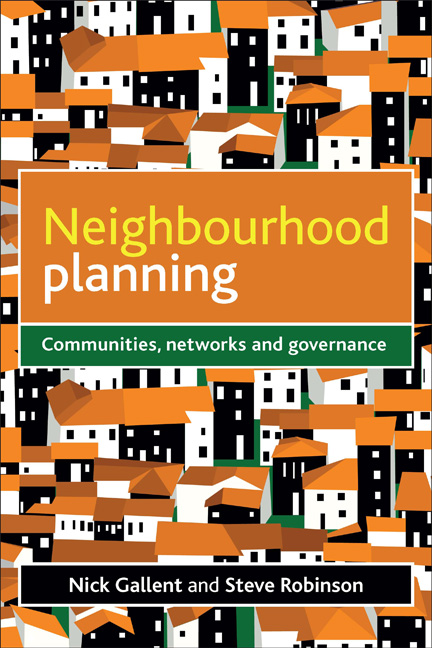Book contents
- Frontmatter
- Dedication
- Contents
- List of figures, images and table
- Abbreviations
- Acknowledgements
- Authors’ note
- Part One Democracy, planning and localism
- Part Two Capacity building and community-based planning
- Part Three The interface with policy actors
- Part Four Neighbourhood planning, leadership and democratic renewal
- References
- Index
five - Ashford and its strategic planning context
Published online by Cambridge University Press: 07 September 2022
- Frontmatter
- Dedication
- Contents
- List of figures, images and table
- Abbreviations
- Acknowledgements
- Authors’ note
- Part One Democracy, planning and localism
- Part Two Capacity building and community-based planning
- Part Three The interface with policy actors
- Part Four Neighbourhood planning, leadership and democratic renewal
- References
- Index
Summary
There has been an ebb and flow of interest in strategic regional planning in the UK (Tewdwr-Jones, 2004), with the strategic perspective and control at the regional level enjoying notably greater support under some governments than others. Planning at this level has its origins in the 1940 Barlow Report (Barlow, 1940), which gave rise to the post-war New Towns programme and broader attempts to redistribute industry and decant people away from inner-urban locations. Strategic regional planning, together with the public building programmes of the post-war era, share a common root in comprehensive planning and public sector control. After the war, successive waves of New Towns signalled periodic returns to stronger central planning at those times when recurrent concerns over regional economic policy intersected with housing shortages (Aldridge, 1979; Gilg, 2005). Yet, the strategic planning function was slow to evolve from the Town and Country Planning Act 1947. The focus at first was on local plans, with their development control and local policy remit. These co-existed with grander strategies for industry and new settlements but were also quite separate. It was not until the late 1960s, with the arrival of ‘structure plans’, at the county level, that a broader framework of cross-border coordination was set in place, which, according to Department of the Environment Circular 44/71 (DoE, 1971), was designed to connect national and regional priorities and programmes (including the New Towns) with more local social, economic and environmental goals.
Connectivity between levels of planning – bringing local issues into broader frameworks – was intended as a key feature of the system, although big strategies often fought against powerful ideological positions: for example, with top-down planning in pursuit of prescribed development outcomes being viewed as insensitive and as a threat to enterprise – a view held by Thatcher after 1979 and Cameron in 2011. In the 1970s, this led to a programme of deregulation and, contrary to the views of successive Labour governments, the belief that the concentration of industry and of people in Southern England was no bad thing, but rather just a consequence of market advantage, which regional planning should not seek to undermine (Tewdwr-Jones, 2002).
- Type
- Chapter
- Information
- Neighbourhood PlanningCommunities, Networks and Governance, pp. 53 - 68Publisher: Bristol University PressPrint publication year: 2012



